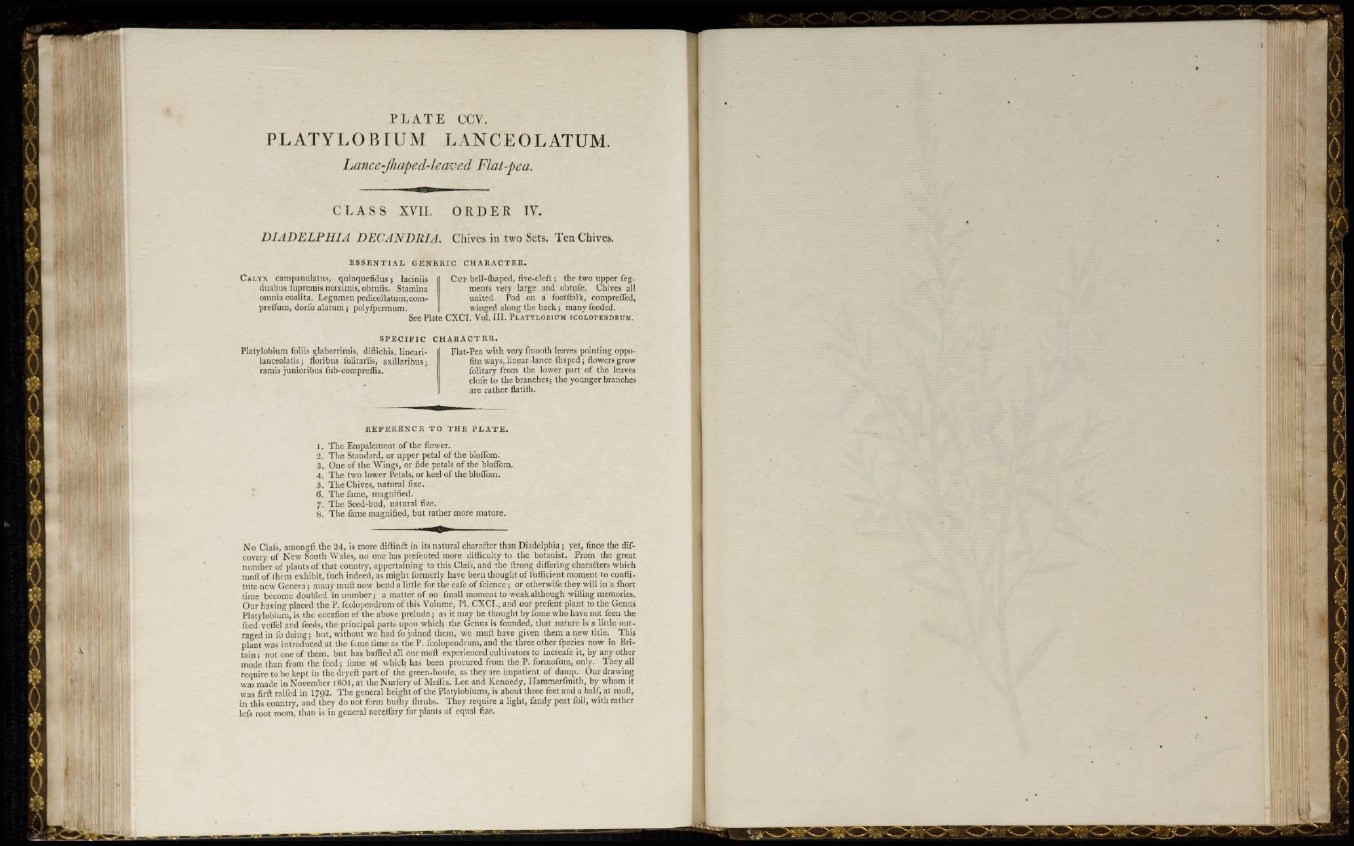
PLATE CCV.
P L A T Y L O B I U M L A N C E O L A T U M .
Lance-Jhaped-lcaved Flat-pea.
CLASS XVII. ORDER IV.
DIADELPHIA DEC A NDRIA. Chives in two Sets. Ten Chives.
E S S E N T I A L GENERIC CHARACTER.
C A L Y X campanulatus, quinquefidus; laciriiis COP bell-iliaped, five-cleft; the two upper fegduabns
fuprcmis maximis, obtufis. Stamina ments very large and obtufe. Chives all
omnia coalita. Legumcn pedicellatum.eom- united Pod on a footltalk, eomprelfed,
preifum, dorib alatum ; polyfpermum. winged along the b a c k ; many feeded.
S P E C I F I C C
Platylobium foliis t;labenimis, diftichis, lineari- |j
lanceolatis; floribua folitariis, axillaribus;
ramis junioribus fub-comprellis.
Flat-Pea w i t h very fmooth leaves pointing oppofite
ways, linear-lance fhaped ; flowers grow
folitary from the lower part of the leaves
clofe to the branches; the younger branches
are rather flatifti.
REFERENCE TO THE PLATE.
1 . The Empalemeut of the flower.
2. The Standard, or upper petal of t h e blolfom.
3. One of t h e Wings, or tide petals of the bloffom.
4. The two lower Petals, or keel of the blolfom.
5. T h e Chives, natural fize.
rj. T h e fame, magnified.
7 . T h e Seed-bud, natural fize.
8 . T h e fame magnified, but rather more mature.
N o Clafs, amongft the 24, is more diftinct in its natural character than Diadclphia; yet, fince the difcovery
of N e w South Wales, no one has preiented more difficulty to the botanist. From the great
number of plants of that country, a p p e r t a i n i n g to this Clafs, and the flrong differing characters which
moll of then] exhibit. Inch indeed, as might formerly have been thought of furficient moment to conftit
u t e new Genera ; many mult now bend a little for the cafe of fciencc ; or otherwife they will in a fliort
time become doubled in n u m b e r ; a matter of no finall moment to weak although willing memories.
Our h a v i n g placed the P. fcoloperdrum of this Volume, PI. C X C I . , and our prefent plant to t h e Genus
Platylobium, is t h e occafion of t h e above prelude ; as it may be thought by fome who have not leen the
feed veflel and feeds, the principal parts upon which the Genus is founded, that nature is a little outraged
in fo d o i n g ; but, without we had fo joined them, we mult have given them a n ew t i t l e . This
plant was introduced at the fame time as the P. fcolopendrum, and the three other fpedes now in Brit
a in ; not one of them, but has balhVd all our molt experienced cultivators to increafc it, b y any other
mode than from the feed; fome ot which has been procured from the P. formofnm, only. They all
require to b e kept in the dry eft part of the green-houle, as they are impatient of damp. Our drawinowas
made in November 1801, a t the Nurfery of Meffrs. Lee and Kennedy, Hammerfmith, by whom it
was firlt railed in 1 7 9 2 . T h e general height of t h e Platy Ioniums, is about three feet and a half, at molt,
in this country, and they do not form bulhy lhrubs. They require a light, fandy peat foil, with rather
lefs root room, than is in general necelfary for plants of equal fize.